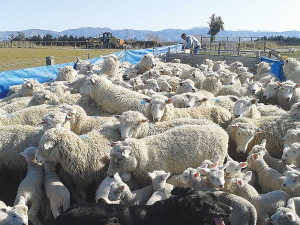Woollen covers that keep newborn lambs safe, warm
A Christchurch manufacturer of woollen covers for newborn lambs says his covers pay dividends in survival rates and liveweight gains, especially at a time when farmers are feeling the economic pinch.
 Early weaning can be particularly useful in hoggets, as they typically lamb later than the mixed-age ewes.
Early weaning can be particularly useful in hoggets, as they typically lamb later than the mixed-age ewes.
Early weaning of lambs can be a valuable management tool that can advantage both ewes and lambs.
With the right quantity of legume-based forages, early-weaned lambs can grow as fast – if not faster – than their unweaned equivalents on traditional ryegrass and clover pastures.
Early-weaned ewes can either be sold early, which frees up feed for other stock, or benefit from having more time to recover body condition before mating.
In late lactation, all lambs, but especially multiples, receive very little nutrition from the ewe. When grass growing conditions are below optimal, the ewes are competing with their lambs, compromising the performance of both.
By weaning them early onto correctly managed, high quality, legume-based forages, the lambs are given more opportunity to realise their genetic growth potential. Weaned lambs should be allowed unrestricted access to high quality, legume dominant pasture (between 1200 kgDM/ha and 2000 kgDM/ha). Or, ideally, a legume-based crop with a height of 7-10 cm.
If lambs are being weaned onto a crop, they should be given time to adjust to a change in feed. Running the ewes and lambs onto the crop for a few days before weaning, then running the lambs back onto the crop after weaning, will minimise the weaning check.
In trials run at Massey University, researchers looked at weaning lambs early, at a minimum liveweight of 16kgLW, onto either a herb-clover mix or a lucerne sward. They found heavier lambs (over 20kg) coped best with early weaning, but the quality of the forage on offer was the biggest determinant of how lambs grow post-weaning.
Early weaning is most effective in seasons when grass growth is limited (pasture covers of under 900 kgDM/ha), and lambs weaned early are offered a herb-clover mix with a minimum pasture cover of 7cm.
Farmers using lucerne, should follow Good Management Practice for lucerne grazing.
Early weaning can be a flexible stock and pasture management tool, used to benefit the whole farm system. For example, weaning a proportion of the flock early means some ewes can be used as a grazing management tool to prepare pastures for when the balance is weaned later.
Early weaning can be particularly useful in hoggets, as they typically lamb later than the mixed-age ewes but mated as two-tooths at the same time. This means that despite their age, they are required to regain body condition more quickly than the older ewes.
Maximising lamb growth rates in the late spring, early summer period has on-going benefits. They are finished faster and therefore consume less feed postweaning. It is easier to breed from heavier ewe lambs as hoggets, and there is flexibility to hold them back later when feed resources are more limited.
Heavy lambs require fewer animal health remedies and less labour inputs, so any management strategy that helps maximise lamb growth rates is worth considering.
Key management factors include:
Three New Zealand agritech companies are set to join forces to help unlock the full potential of technology.
As the sector heads into the traditional peak period for injuries and fatalities, farmers are being urged to "take a moment".
Federated Farmers says almost 2000 farmers have signed a petition launched this month to urge the Government to step in and provide certainty while the badly broken resource consent system is fixed.
Zespri’s counter-seasonal Zespri Global Supply (ZGS) programme is underway with approximately 33 million trays, or 118,800 tonnes, expected this year from orchards throughout France, Italy, Greece, Korea, and Japan.
Animal owners can help protect life-saving antibiotics from resistant bacteria by keeping their animals healthy, says the New Zealand Veterinary Association.
According to analysis by the Meat Industry Association (MIA), New Zealand red meat exports reached $827 million in October, a 27% increase on the same period last year.